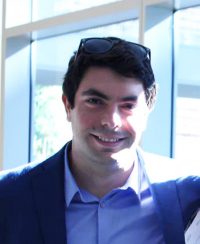Wide-field Imaging and Tracking in 3D Using Computational On-Chip Microscopy

Speaker: Mustafa Uğur Daloğlu
Affiliation: Ph.D. Candidate - UCLA
Abstract: On-chip microscopy is a powerful technique for high-throughput 3D microswimmer tracking and wide-field nanoparticle/biomolecule imaging, as it does not suffer from the limitations of its lens-based counterparts. Due to the simple geometry where the sample is placed very close to the sensor chip without any imaging lenses in between, the field-of-view (FOV) is decoupled from the spatial resolution and is equal to the area of the sensor chip. Illuminated by a partially-coherent or coherent light source, volumetric information from the sample is recorded as interference patterns on the sensor, which is digitally reconstructed to extract the amplitude and phase information of the target objects. We further improve the capabilities of this unique imaging modality, enabling it to reach new frontiers in 3D sperm tracking and nanoparticle/biomolecule imaging.
First, we enabled the on-chip imaging platform to track the 3D flagellar motion of bovine sperm cells along with the head spin, in addition to the 3D translational motion of the sperm head, by significantly increasing the frame capture rate and the sensitivity. We have quantified >2,100 bovine sperm trajectories in 3D, with the associated flagellar beating patterns, the head spin axis and velocity. We provide, for the first time, the perspective of an observer that is seated at the moving and spinning sperm head. We further use this platform to track and comparatively analyze the full 3D locomotion of sex-sorted bovine sperms, investigating the differences in the kinematics between the two sperm populations carrying the opposite sex chromosomes.
Second, we improve the nanoparticle detection limit of our platform by using a shorter illumination wavelength in the middle ultraviolet range (266 nm) to increase the forward scattering, which enabled us to detect individual sub-30 nm nanoparticles. This short wavelength has also allowed us to image biomolecules (e.g. protein aggregates) with increased contrast, due to the high absorption specific to the UV wavelengths. We further investigate a UV-LED based, low-cost and portable version of this platform to image protein crystals in high-contrast and to distinguish them from salt crystals, as a potential alternative to the lens-based platforms used by protein crystallographers.
Biography: Mustafa Uğur Daloğlu is a Ph.D. student, working under the supervision of Prof. Aydogan Ozcan in the Electrical & Computer Engineering Department at UCLA, developing high throughput imaging platforms for nanoparticle/biomolecule imaging and 3D microswimmer tracking. He earned his MS in 2015 from UCLA and his BS in 2013 from Bilkent University (Turkey), both in Electrical Engineering.
For more information, contact Prof. Aydogan Ozcan (ozcan@ucla.edu)
Date/Time:
Date(s) - Oct 11, 2018
3:00 pm - 5:00 pm
Location:
E-IV Tesla Room #53-125
420 Westwood Plaza - 5th Flr., Los Angeles CA 90095
